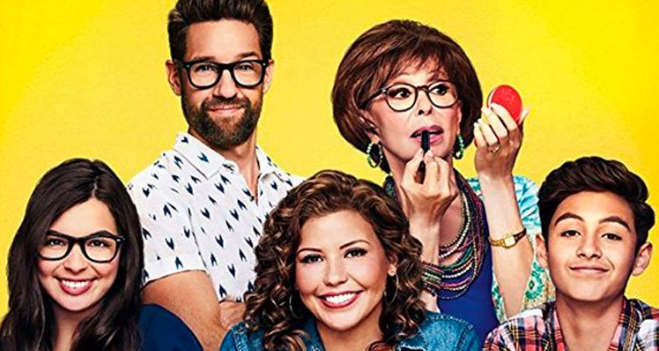Sitcoms notionally allow you to just sit back and go into de-stress mode as you watch something light and comic. Well, this one certainly is an exception. Tracing its roots from the 1975 series with the same name, One Day At a Time has made some bold statements and has brought up many underlying social issues – all while maintaining the humour and witty remarks. The show, which aired first in 2017 on Netflix, does not only deal with the sensitive issues such as mental health, racism, religion, and the challenges faced by the migrants, but it is also impressively unapologetic when it comes to gender-related subjects. Here are a few of the many reasons that make the show phenomenal.
1. Challenging Gender Roles And Traditional Family Structures

Undoubtedly, it takes a lot more than a mere role reversal in order to actually initiate a change. Instead of compartmentalising the social roles again, even if it is in an upside-down fashion, it is more important to understand and notice the very existence of these binaries and erase them thoroughly. One Day At a Time provides an unusual family structure wherein a 70 something woman (Lydia) and her daughter (Penelope)
Also read: Brown Girls Is Unapologetically Honest About Queer Women Of Colour
In fact, the two teenagers in the house, Elena and Alex (Penelope’s children), also go on to explore their preferences and interests. While Elena, for instance, takes interest in becoming the building’s handy-person, Alex is quite protective of his ‘pretty face’. However, this does not confine their characters in some tightly categorised and inverse gender roles.
2. Queer Representation
One Day At a Time, represents homosexuality as one of its major themes. In the first season of the show, Elena becomes certain of the fact that she identifies as a lesbian and finally comes out to her family. Now, a remarkable aspect of this thematic story line is not only the family’s reaction to it, but also Elena’s acceptance of herself.
With the theme of homosexuality, the plot does not only focus on Elena but also on how the other characters of the show see her subsequently. While Elena’s father, Victor, is not supportive of her, Penelope actually makes an attempt to understand and come to terms with the identity of her daughter. All in all, this particular theme only adds more substance and layers to all the characters in the show.
As a part of popular culture, the show efficiently portrays a wide range of gender-related issues.
Another interesting part of this entire episode is the way Lydia understands Elena’s sexuality. She indeed surprises the viewers when she takes only a few seconds to figure out that religion and morality did not come in the way of Elena’s sexuality. Later, she even defies the tradition and sews a suit instead of a gown for Elena’s Quinceañera. This transformation of Elena’s dress also stands as a symbolic acceptance of identity.
3. Challenging Sexism and Ageism
Well, undeniably, ageism and sexism often come together in a single package. The gender roles do undergo some changes with age. To rephrase, men and women of different age groups are expected to behave according to their respective gender and age. Likewise, for older women, the unwritten social code expects them to conduct themselves in a certain way. For instance, wearing make-up or following latest fashion trends do not appear to be the normative behavioural traits for a woman who is in the later stage of her life.
while the social code preaches the asexual behaviour and a lack of identity among older women, Lydia goes on to establish an identity of her own
However, Lydia Riera from One Day At a Time breaks all the barriers by following her love for lip shades and earrings even after crossing seventy. Constantly associating her beauty with power, Lydia also never shies away from expressing her sexuality. In fact, while the social code preaches the asexual behaviour and a lack of identity among older women, Lydia goes on to establish an identity of her own. In the series, she is never shown as a ‘typical’ grandmother figure but as a proficient dancer, a courageous migrant, and a strong and protective figure for her family.
4. Women Standing Up For Women
A significant theme which One Day At a Time deals with is female camaraderie. The female characters of the show are often seen cohesively supportive of each other. For instance, despite insisting Penelope
Another perfect exemplar of this phenomenon is the support group which Penelope joins. The support group for war-veterans does not only provide these women with space where they could share their ups and downs, but it also brings up their personal narratives from the time when they served in the army. With instances like these, One Day At a Time makes its audience normalise and celebrate women standing up for other women.
Also read: Netflix’s Sex Education Is Not Afraid To Talk About Sex
As a part of popular culture, the show efficiently portrays a wide range of gender-related issues. From gender bias at the workplace to the on-street sexism, the series is vocal about the myriad challenges which women face on a regular basis. With its comic yet thought-provoking structure, the show goes on to influence its viewers tremendously.
Featured Image Source: Out
About the author(s)
Yashda Garg is a feminist author based in Faridabad. She has written a fiction novel, numerous articles, poems and short short stories. Her latest book Gender and Gyves revolves around the gender issues prevalent in the society.




